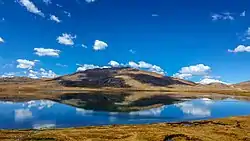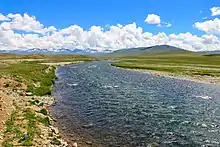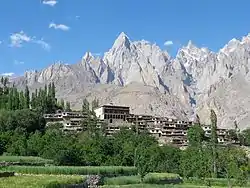Deosai National Park
The Deosai National Park is a high-altitude alpine plain (plateau) and national park in the Northern Pakistan region of Gilgit Baltistan.
| Deosai National Park | |
|---|---|
 The Deosai Plains are the world's second highest alpine plains (plateau) | |
| Location | Astore GB Pakistan |
| Coordinates | |
| Area | 843 km2 (325 sq mi) |
Deosai Plains are situated at an average elevation of 4,114 metres (13,497 ft) above sea level and considered as the second highest plateaus in the world.[1]
Etymology

The name came about from the folk tale immortalised by Mian Muhammad Baksh in his poem, "Saif al-Mulook"; the word 'Deosai' means 'the Shadow of the Giant': the word "Deo" being a contraction of 'Deva', and the word 'Sai' being one of 'Saya' i.e. 'Shadow'.
Balti people call this place 'Ghbiarsa' referring to 'Summer's Place' because it is only accessible in summer.
Geography

The Deosai National Park is located between Kharmang, Astore and Skardu in Gilgit Baltistan (GB), Pakistan. It has an average elevation of 4,114 metres (13,497 ft) above sea level,[2] making the Deosai Plains the second[3] highest plateau in the world after Changtang Tibetan Plateau. The park protects an area of 843 square kilometres (325 sq mi). It is well known for its rich flora and fauna of the Karakoram-West Tibetan Plateau alpine steppe eco-region. In spring, it is covered by sweeps of wildflowers and a wide variety of butterflies.
Travel routes to the region
Deosai is accessible from Skardu District in the north, Galtari Kharmang District in the south-east and the Astore District in the west. It is also accessible from Mehdiabad via Mehdiabad-Dapa Road. Deosai is located approximately 30 km from Skardu city, which is the shortest route to visit Deosai. Another route is from Astore valley via Chilim. It is also accessible from Shila valley. The people of Galtari travel via Deosai. While it is a National Park, the Gujjar-Bakwarwal travel large distances to utilize the Deosai National Park as grazing lands.[4] There is another route called Burgi la via Tsoq Kachura valley Skardu.[5][6][7]
Geology and soil
The soils of this area are severely eroded, of a coarser nature and mixed with gravel and stones of various materials and sizes. In flat areas between mountains, soil is deep with marshy vegetation.
Fauna and Flora
.JPG.webp)
The Deosai National Park was established in 1993 to protect the survival of the Himalayan brown bear and its habitat. Having long been a prize kill for poachers and hunters, the bear now has a hope for survival in Deosai where its number has increased from only 19 in 1993 to 40 in 2005. In 1993, after playing an instrumental role in the designation of Deosai as a National Park, the Himalayan Wildlife Foundation (formerly the Himalayan Wildlife Project) was founded with a substantial international financial support. The Himalayan Wildlife Foundation ran two park entry check posts and a field research camp in Deosai for approximately ten years. Documentation was completed by the Himalayan Wildlife Foundation for the handover of the management of the Park to the, then, Northern Areas Forest Department with the department starting to manage the park since 2006. While pressures that existed in the 1990s, such as hunting and poaching have subsided, the brown bear is still under threat due to pressures such as increasing numbers of tourists and the use of park areas for grazing.
The Deosai Plains are also home to the Himalayan ibex, red fox, golden marmot (locally called Phia), gray wolf, the Ladakh urial, snow leopard and over 124 types of resident and migratory birds. Birds in the park include the golden eagle, lammergeier, griffon vulture, laggar falcon, peregrine falcon, Eurasian kestrel, Eurasian sparrowhawk, and snowcock.
The following species are found in Deosai:
Artemisia maritima, Polygonum affine, Thalictrum alpinum, Bromus oxyodon, Saxifraga flagellaris, Androsace mucronifolia, Aster flaccidus, Barbarea vulgaris, Artemisia maritima, Agropyron longearistatum, Nepeta connate, Carex cruenta, Ranaculyus laetus, Arenaria neelgerrensis, Astrogalus leucophylla, Polygonum amplexinade, Echinop nivetus, Seria chrysanthenoides, Artemisia maritima, Dracocephalum nutsus, Anapalas contorta, Chrysopogon echinulatus and Dianthus crinitus. There were also observed some medicinal plants which are locally famous i.e. Thymu linearis (Reetumburuk), Saussures lappa (kuth), Ephedra intimedia (Say), Viola canescens (Skora-mindoq), Dracocephalum muristanicum (Shamdun) and Artemisia maritima (Bursay) etc. are used as traditional drug therapies.
Cultural references
Herodotus
Research by the French ethnologist Michel Peissel makes a claim that the story of 'Gold-digging ants' reported by the Greek historian Herodotus, who lived in the 5th century BC, was founded on the golden Himalayan Marmot of the Deosai plateau and the habit of local tribes such as Minaro to collect the gold dust excavated from their burrows.[8]
In film
- The documentary film series Land of the Tiger in episode 5 - the "Mountains of the Gods" features the plants and animals of Deosai.
- Karakoram Heliski 2013 by Walkabout Films
- Documentary movie "DEOSAI - The Last Sanctuary" by Walkabout Films
References
| Wikivoyage has a travel guide for Deosai National Park. |
- Öztürk, Münir; Hakeem, Khalid Rehman; Faridah-Hanum, I.; Efe, Recep (2015-05-05). Climate Change Impacts on High-Altitude Ecosystems. Springer. p. 456. ISBN 9783319128597.
- Öztürk, Münir; Hakeem, Khalid Rehman; Faridah-Hanum, I.; Efe, Recep (2015-05-05). Climate Change Impacts on High-Altitude Ecosystems. Springer. ISBN 9783319128597.
- "Plateau".
- Rafiq, Arshed. "Nomadic life: A struggle against climate change and authorities". Earth Journalism Network. Retrieved 2019-06-07.
- "Deosai: Anything but plain". The Express Tribune. Karim Shah Nizari. 17 July 2011.
- "Deosai Plains: Welcome to surreal Pakistan". DAWN. Syed Mehdi Bukhari. 27 April 2015.
- "My search for the elusive 'giant' of Deosai". DAWN. Osman Ehtisham Anwar. 9 April 2016.
- Peissel, Michel. "The Ants' Gold: The Discovery of the Greek El Dorado in the Himalayas". Collins, 1984. ISBN 978-0-00-272514-9.

